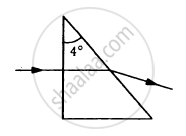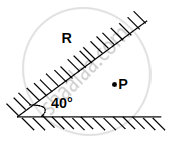Advertisements
Advertisements
प्रश्न
a) Give two reasons to explain why reflecting telescopes are preferred over refracting type.
उत्तर
(a) The reflecting telescopes are preferred over refracting type because of the following reasons:
(i) There is no chromatic aberration in case of reflecting telescopes as the objective is a mirror.
(ii) Spherical aberration is reduced in case of reflecting telescopes by using mirror objective in the form of a paraboloid.
APPEARS IN
संबंधित प्रश्न
Calculate the distance of an object of height h from a concave mirror of radius of curvature 20 cm, so as to obtain a real image of magnification 2. Find the location of the image also.
An object is kept on the principal axis of a concave mirror of focal length 10 cm. at a distance of 15
cm from its pole. The image formed by the mirror is:
(a) Virtual and magnified
(b) Virtual and diminished
(c) Real and magnified
(d) Real and diminished
Can a plane mirror ever form a real image?
Mark the correct options.
A cylindrical vessel of diameter 12 cm contains 800π cm3 of water. A cylindrical glass piece of diameter 8.0 cm and height 8.0 cm is placed in the vessel. If the bottom of the vessel under the glass piece is seen by the paraxial rays (see figure), locate its image. The index of refraction of glass is 1.50 and that of water is 1.33.

Find the angle of deviation suffered by the light ray shown in figure. The refractive index μ = 1.5 for the prism material.

A light ray, going through a prism with the angle of prism 60°, is found to deviate by 30°. What limit on the refractive index can be put from these data?
An upright object is placed at a distance of 40 cm in front of a convergent lens of a focal length of 20 cm. A convergent mirror of focal length 10 cm is placed at a distance of 60 cm on the other side of the lens. The position and size of the final image will be ______.
Two plane mirrors are inclined at an angle of 40°. The possible number of images of an object placed at point P would be?

A convex lens of focal length 15 cm is placed coaxially in front of a convex mirror. The lens is 5 cm from the pole of the mirror. When an object is placed on the axis at a distance of 20 cm from the lens, it is found that the image coincides with the object. Calculate the radius of curvature of the mirror - (consider all-optical event):
